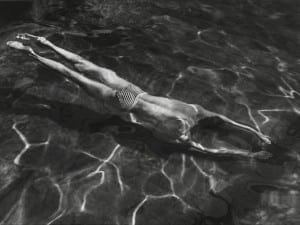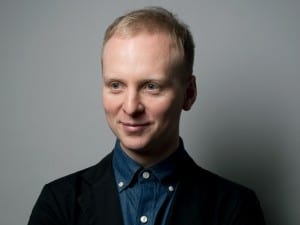Performance art is complex, and requires audiences to experience works in new ways. One of the early pioneers, Stuart Brisley discusses his seminal pieces from the 1970s.
Stuart Brisley (b. 1933) is often called the “godfather of British performance art.” He began his career as a painter and a sculptor in the 1950s, and today still produces drawings, paintings, sculptures, and site-specific installations. But when he turned to performance in the late 1960s and early 1970s, his work broke fresh ground for performance art, taking it to a new and exciting level, galvanizing his career and reaching critical acclaim. Influenced by Marxist counter-culture politics from the 1960s, he embraced performance as an autonomous foundation for a new rapport between artist and audience. While consistently producing new work, these older works continue to be exhibited and performed by younger artists, who are paying homage to Brisley’s revolutionary ideas.
One of his first pieces to receive widespread attention was And for today… nothing (1972). In a darkened gallery bathroom, surrounded by rotting offal with maggots hatching inside, Brisley lay immersed in a bath of black water, somewhere between sinking and drowning. In 1973, this work was reprised, but this time his face was wrapped in a latex caul, pinned under a Perspex sheet with the water rising to form a complete trap. This became the 20-minute film Arbeit Macht Frei (Work Makes Free), which were the wrought iron words above the entrance to many of the Nazi concentration camps. The film opens with a “bodily rejection” of the idea, a protracted, ritual vomiting over the strains of “God Save the Queen” played backwards. The film was created as an analogous representation of the abject disgust of genocide.
Brisley’s initial performances were compelled by necessity. In Munich, with little money, he stole tar and sand from building sites by night and made works out of them by day. Later, living in Florida, he crawled under stilt houses to rescue household debris for sculptures. In New York State, while teaching at Cornell University, he explored the junkyards, describing them as “amazing places that were like huge cities.” His art recalls what Picasso famously said in 1945 about his Bull’s Head made of a discarded bicycle seat and handlebars: “The metamorphosis will be complete when the sculpture is cast on a trash heap with other fallen objects, and some day someone takes them home because they’re just right as handle bars and seat to fix his bike.” Inspired, Brisley made sculptures out of scrap and returned them to the landfill, as a kind-of site-specific installation. When his US visa expired, Brisley returned to England, an experience he describes as “shrinking to fit.” His work reflected this feeling by experimenting with “dematerialisation” and “working with directions and moving towards nothing,” until he hit upon the idea of “making actions instead of things. After all, I thought, we’re on the earth, we eat and we sleep.”
For ZL656395C (1972), a performance at Gallery House, London, Brisley changed his name by Deed Poll to his National Insurance number and moved into an isolated room in the gallery that he made squalid with water and paint. The only object in the room was an antique wheelchair, and the performance was watched through a small hole in the door, where food was also passed to him. The performance traces the recession of punishment and control from view – from the torture of the body, to its incarceration, to the less visible control methods anchored within the individual himself. The artist submits himself to “torture” and the gallery “the institution”, becomes a work place, prison, dystopia or even hell. This seminal piece is now part of the permanent Tate Collection.
This summer, Ikon gallery in Birmingham is re-showing the works from You Know It Makes Sense (with reference to allegations made against the British Army in Ulster concerning torture), as part of their current programme, This Could Be You: Ikon in the 1970s, which was originally performed at the gallery in 1972. Brisley was responding to allegations in the Irish Times of torture methods used by the British Army to extract confessions from Republican prisoners in Northern Ireland. The British Prime Minister at the time, Ted Heath, banned torture methods that were condemned by the European Court of Human Rights as being inhumane and degrading. The title of the piece, You Know It Makes Sense, refers to Labour PM Harold Wilson’s election campaign slogan in the 1960s. For the piece, Brisley invited members of the public (Everelde Berry, Deborah Brisley, Janet Deuters and Michael Melluish) to participate in the performance. This was held in a room, splattered with paint instead of blood, and the newspaper reports were scattered across the floor. Before the performance, Brisley gave each participant a set of actions to complete, and told them they could also respond to the actions of others. The resulting scene was chaotic and violent, but no acts of brutality occurred.
Brisley’s career progressed and in 1975 he performed 12 days in Rottweil, Germany. For this performance, the artist constructed a wooden frame, with smaller frames inside, gradually retreating into a tiny space. At the end, before an audience of 500 people, he broke out of the prison he had built for himself. For Measurement and Division, performed at the Hayward Gallery, London in 1977 with Christoph Gericke, Brisley constructed a scaffold-like structure, in which he was suspended upside down. Brisley worked again with Gericke for his performance, Survival in Alien Circumstances at the Documenta VI Arts Festival in Kassel (1977). On the outskirts of the festival, they dug a hole in the ground by hand, this action was repeated continuously. The pair didn’t explain their actions to onlookers; they just dug relentlessly, with a spare shovel on-hand if anyone offered to help. Asked what they thought it could be, locals and visitors declared a “mass grave.” Over two weeks of digging, the pair discovered human bones among the rubble. What Brisley stumbled upon was a destroyed building from the Second World War. As they dug deeper, the digging grew harder. They had to smash through a solid concrete floor, and then they hit the water-table, ending up to their necks in water. A wooden hut was constructed on a platform sunk into the hole, in which Brisley lived for two weeks. Like David Blaine in his 2003 performance Above the Below, suspended in a Plexiglas box near London’s Tower Bridge, guards had to be brought in to protect Brisley’s box from missiles launched by spectators.
At the Acme Gallery in London, Brisley performed 180 Hours Work for Two People (1978). He took both roles: “B”, a vocal bureaucrat inhabiting the upstairs part of the gallery, carefully preserving his urine and excrement and hanging it in a hole in the floor, above “A” who lives downstairs, a man-off-the-street as active as “B” was vocal, but who says nothing. When “A” “disappeared”, “B” began playing his part, wondering aloud where “A” had gone. On the final day of the performance, Brisley heard screaming from the foyer. A woman from a psychiatric ward at a nearby hospital had been attending the performance each day, convinced that the resolution to her problems lay in the resolution of the work. She had arrived too late, missing the end, and was driven back to hospital in a taxi screaming.
Brisley describes performance as a departure from this “ordinary social self”, and gaining “a sense of identity with the audience” that is neither social, nor intimate: it comes when it comes and fades away, often before the end of the performance, but it’s impossible to recapture. This sentiment lasts only as long as the performance: the message transmitted, the portal closes, and the social self that was is momentarily reinstated. His works were not about establishing a direct and intimate relationship with the audience. He was more like a mirror, reflecting back to the audience the social structures that existed within them. However, Brisley the performance artist and Brisley the social being were not always interchangeable. Brisley was active in his community; he helped set up the Artists’ Union in London, and supported the Hornsey sit-in in 1968. He also worked with mining communities in Peterlee to set up an oral history project, and with the homeless people in his street for The Georgiana Collection (1978-86). But these projects ran parallel to the performance persona. They were not extensions of it. They were practical interventions, and not in themselves art projects.
Throughout the 1970s Stuart Brisley performed over 30 major works. It was an important decade for him, offering a critique of the norms and mores of society, while simultaneously redefining the boundaries between performer, audience and gallery. Brisley’s works in the 1970s were often uncomfortable, radical, pioneering, but this “action art” was a living force. In the 1980s Brisley continued to create new works, including Leaching Out at the Intersection (ICA, London, 1981), which was at the time part of the uncompleted larger project, The Georgiana Collection. Based on Brisley’s doorstep, Georgiana Street was a wasteland covered in rubbish. He watched a cardboard suitcase slowly disintegrate, which gave him the idea for the work. This piece lasted 30 days and commented on institutional order, material goods and objects used in life. From the 1990s to the present day, Brisley continued his impetus for performance with several key works being formed, but he also returned to painting, mixed-media and sculpture with many pieces now in the British Museum Collection. Brisley’s understanding and codification of the world that we inhabit, and his precise dissection of its complexities is hugely important, not only in the realm of performance art, but in the wider context of contemporary artistic practice.
Speaking this past June in Berlin at EXILE with Andrew Wilson (Curator for Modern and Contemporary British Art for Tate), Brisley discussed the difficulty of knowing what a performance is and where it exists, because in his works that go on for weeks, no one sees the entirety. If the audience doesn’t “see” the entire performance, is it still a performance? Where does the performance go when it’s over? “In the course of these performances, it’s what happens outside the performance that amplifies the work.” These strange occurrences “produce a narrative around the work.” For Brisley, it’s this narrative that “validates the work.” The performance is a frame for gathering happenings. But the “work” exists only at the vanishing point of performance – where it disappears into the lives and experiences of its witnesses, and where it begins to “perform back” at the artist. These are the very parts of the performance that can never be shown, only spoken. Brisley’s collaborator, Christoph Gericke, put it well: “Whenever anyone asks me to talk to them about what happened [during the performances], I’m happy to. But if anyone asked me to write it down or record it any way, I just wouldn’t know how. I couldn’t do it. I wouldn’t want to.” Brisley now relates these “fragments”, or missing pieces whenever he speaks about his works. In a way, he’s still looking for discarded objects to turn them into something new and maybe useful. With Stuart Brisley the mute encounters of performance art have performed their own strange alchemy, and resurrected something many thought to be altogether long dead. The performance artist has turned into a storyteller.
You Know It Makes Sense continued at Ikon until 5 September 2010. Arbeit Macht Frei was part of the group show, Goodbye London – Radical Art and Politics in the Seventies at the Neue Gesellschaft für Bildende Kunst (NGBK) in Berlin until 15 August 2010 and in February 2011, Brisley had a solo show at Mitchell Algus Gallery in New York City. More of Brisley’s works can be viewed on the artist’s website: www.stuartbrisley.com.
Sam Williams




